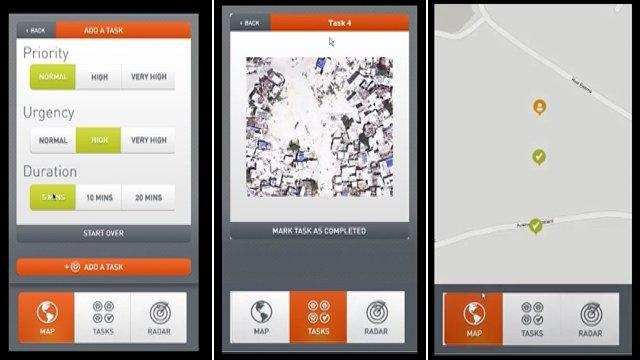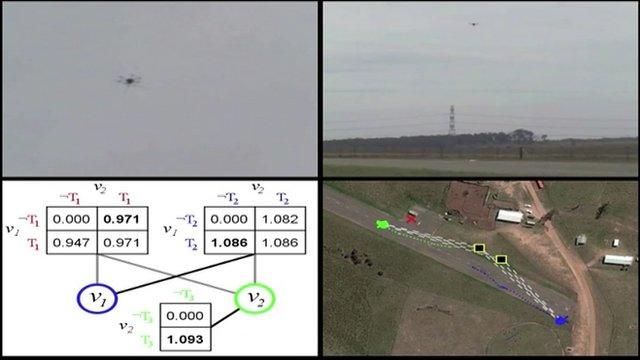Disaster drones: How robot teams can help in a crisis
- Published
Professor Nick Jennings explains his research into disaster drones
An ominous plume of black smoke hangs over east London. The scarcely believable news arrives in snippets: A huge blast has rocked the Thames Barrier; a surge of water is ploughing through the city; a sports stadium has collapsed; more explosions are reported on Twitter.
Thousands of people are trying to evacuate, but like the banks of the Thames, the mobile networks are overwhelmed.
It is time to send in the drones.
Professor Nick Jennings prefers to call them unmanned aerial vehicles (UAVs). He is one of the chief scientific advisers to the government, and drew up <link> <caption>this fictional scenario</caption> <altText>this fictional scenario</altText> <url href="http://www.orchid.ac.uk/disaster-response-2/" platform="highweb"/> </link> as part of his multi-million pound Orchid research project.
Prof Jennings believes the key to mastering the pandemonium that follows large-scale disasters lies in intelligent, co-ordinated action between man and machine.

Prof Nick Jennings heads the Agents, Interaction and Complexity Group at Southampton University
The system he is testing will be ready next year, and will allow teams of drones to help emergency services from the air with minimal human supervision. It is yet another non-military spin-off in the burgeoning field of drone technology.
After studying real disasters like the Haiti earthquake of 2010, Prof Jennings realised that the key to successful disaster response - amidst all the chaos - is the intelligent allocation of tasks and resources, and humans on the ground are not always best placed to make those life and death decisions.
"Humans can do things like fill in maps based on what they see, starting from a blank map, which is exactly what happened in Haiti. What buildings are damaged, where facilities are, that kind of basic crowd-sourcing already happens," says Prof Jennings.

Aerial view of Haiti after the earthquake: Relief agencies currently fill out physical maps
"But we want to augment that with autonomous flying vehicles that are able to get a view of the bigger picture on the ground, to improve situational awareness. They can figure out where the disaster responders should go, where the resources should go."
In his proposed system, UAVs will be launched immediately to monitor the unfolding disaster from the air.
They will provide real-time footage to disaster responders on the ground, who can request specific information from the drones using hand-held electronic devices.
They might ask, for example, 'how stable is this building's roof?' before entering to look for victims.
"We could also have robots on the ground, that would go into areas too dangerous for humans," says Prof Jennings.

Handheld devices similar to this model (showing three screenshots) allow first responders to allocate tasks to drones, view live overhead video feeds from them, and mark tasks as completed, all on one shared platform
His team is looking at ways that information from members of the public sent by smartphones could be integrated into this system.
Research into non-military applications for drone technology is a booming area, with companies vying to find commercial applications.
From their origins as expensive pieces of military hardware, the price of drones themselves has fallen dramatically, to the point where they are even within the budget of the hobbyist.
Private individuals are adapting these drones, which are capable of programmable flight paths, for their own uses, including everything from wildlife surveillance to farm management.
BAE Systems recently unveiled its research into technology that could allow pilot-less planes to fly in UK airspace, potentially for operations like border control and search and rescue.
But what makes Prof Jennings's research stand out is that he is interested in allowing drones to fly as squadrons, improvising their own flight paths as a unit in response to new information, without human intervention.
The teams of drones that will patrol a disaster have already been tested extensively in Sydney, Australia.

Algorithms dictate the co-ordinated movement of the drones as they respond to requests from humans. Tests take place in Australia rather than the UK because of airspace restrictions
The drones he uses are in fact Mikrocopter Hexacopters, which have six rotary blades and are just under a metre in width.
"The underlying research is based on aspects of artificial intelligence, getting software to do clever things, and underpinning that is a form of mathematics", explains Prof Jennings.
During tests, the drones are flown as a unit and allocated multiple tasks from the ground. What is in fact being tested on site is the mathematical algorithms that control the drones' joint movement.
If successful, these algorithms will direct the drones so that they are in the optimal position to collect information requests from humans and distribute them back to the ground.

A poster in Prof Jennings' lab explains how a team of drones interacts with ground crew
'Decentralised coordination algorithms' are intelligent enough to deal with out of sync data requests, lost data, and can even predict where future requests will come from. They allow the drones to communicate between each other and work effectively as a team.
The algorithms themselves have already been tested on computer software, like RoboCup Rescue Simulator, that simulates human catastrophes with mock ups of people fleeing towns and cities.
"The next stage," says Prof Jennings, "is to run some mock disasters in open spaces, and have individual human actors in there, interacting with the robots, doing it for real."
This is scheduled to take place in October.
A fully operational system is said to be 18 months away.
Several police forces are already interested, Pof Jennings says, and he hopes both governments and NGOs will take up the technology.
So if in the future you are unfortunate enough to find yourself caught up in a terrorist attack or natural disaster and see a robot hovering above your head, take heart - help may be closer than you think.
- Published29 June 2012
- Published29 June 2012
- Published31 January 2012